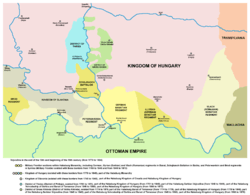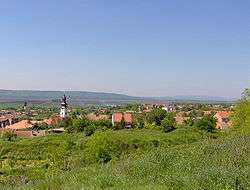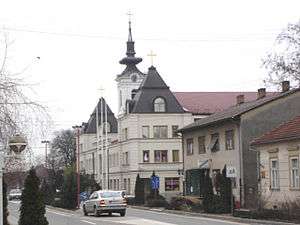Šajkaška
| Šajkaška Шајкашка | |
|---|---|
| Geographic region of Serbia | |
 Map of Šajkaška | |
| Country |
|
| Largest city |
Žabalj Titel |
| Population | |
| • Total | 67,355 |
Šajkaška (Шајкашка) is a historical region in northern Serbia. It is southeastern part of Bačka, located in the Autonomous Province of Vojvodina. Territory of Šajkaška is divided among four municipalities: Titel, Žabalj, Novi Sad, and Srbobran. Historical center of Šajkaška is Titel.
Name
Name Šajkaška means "land of šajkaši". Šajkaši were a specific kind of Austrian army, which moved in narrow, long boats, known as "šajka". These military units have operated on the Danube, Tisa, Sava and Moriš rivers. In Hungarian, the region is known as Sajkásvidék and in German as Schajkaschka.
History
After the Treaty of Karlowitz in 1699, the region was part of the Habsburg Monarchy. Most of Šajkaška was included into Habsburg Military Frontier (its Danube and Tisa sections), while one part of the region was included into Bodrog County. When these parts of Military Frontier were abolished (in 1750), Šajkaška was included into Theiss District, which was part of the Batsch-Bodrog County within the Habsburg Kingdom of Hungary. In 1763, Šajkaška was excluded from Theiss District and was again placed under military administration. Šajkaš Battalion, as part of Military Frontier, was founded in this area. In the beginning of the Habsburg administration, the population of the region was composed entirely of Serbs, which were brave and skillful warriors. Serb Šajkaši have participated in many battles against Ottoman Empire.

In 1848-1849, region was part of autonomous Serbian Vojvodina, but was again included into Military Frontier in 1849. In 1852, Šajkaš battalion was transformed into Titel infantry battalion. This military unit was abolished in 1873, and region was again incorporated into Bács-Bodrog County. Administratively, territory of Šajkaška was organized into municipality of Titel and separate municipality of Žabalj was also later established. In 1910, ethnic Serbs formed an absolute majority in both municipalities. Besides Serbs who formed majority in most settlements, region was also populated by Hungarians who formed majority in the village Budisava and sizable minority in few other settlements, Germans who formed sizable minority in several settlements and Rusyns who formed sizable minority in Đurđevo.
In 1918, as part of Banat, Bačka and Baranja region, Šajkaška became part of the Kingdom of Serbia and then part of the newly formed Kingdom of Serbs, Croats and Slovenes (later renamed to Yugoslavia). From 1918 to 1922 Šajkaška was part of the Novi Sad County, from 1922 to 1929 part of the Belgrade Oblast, and from 1929 to 1941 part of the Danube Banovina. From 1941 to 1944, region was occupied by the Axis Powers and was attached to Bács-Bodrog County of the Horthy's Hungary. In 1942 raid, Hungarian occupational authorities killed numerous ethnic Serbs, Jews and Romani in Šajkaška. In 1944, Soviet Red Army and Yugoslav partisans expelled Axis forces from the region and Šajkaška became part of the autonomous province of Vojvodina within new socialist Yugoslavia. Since 1945, AP Vojvodina is part of the People's Republic of Serbia within Yugoslavia. Today, Šajkaška is mainly agricultural region, with well-developed food industry.
Demographics
In 2002, population of Šajkaška numbered 67,355 people, including:
- Serbs = 57,418 (85.25%)
- Hungarians = 3,170 (4.71%)
- Rusyns = 1,474 (2.19%)
- Romani = 1,166 (1.73%)
- Yugoslavs = 987 (1.47%)
- Croats = 511 (0.76%)
- Slovaks = 228 (0.34%)
Places of Šajkaška
Titel municipality:
Žabalj municipality:
Novi Sad municipality:
Srbobran municipality:
Note: Titel and Žabalj are towns and administrative centres of municipalities. Other places are villages.
Culture
There is a Serb Orthodox Kovilj monastery in the area. It is situated near the village of Kovilj. The monastery was reconstructed in 1705-1707. According to the legend, the monastery was founded by the first Serb archbishop Saint Sava in the 13th century.
Gallery
See also
References
- Mirko Mitrović (1975). Šajkaška: istorija. 2. Matica srpska.
- Šajkaška: istorija. 1. 1975.
- Šajkaška u Narodnooslobodilačkoj borbi. Progres. 199X.
- Bukurov, Branislav, ed. (1971). Šajkaška - priroda kraja.
- Branislav Bukurov (1975). Šajkaška: istorija. 1. Matica srpska.
- Bernhard Hänsel (1998). Das Plateau von Titel und die Šajkaška: archäologische und naturwissenschaftliche Beiträge zu einer Kulturlandschaft. Oetker-Voges. ISBN 978-3-89646-054-7.
- Dragan Kolak, Šajkaška, Enciklopedija Novog Sada, knjiga 30, Novi Sad, 2009.
- Titelski letopis, Titel, 2001.
External links
- About Šajkaška (in Serbian)
| Wikimedia Commons has media related to Šajkaška. |







